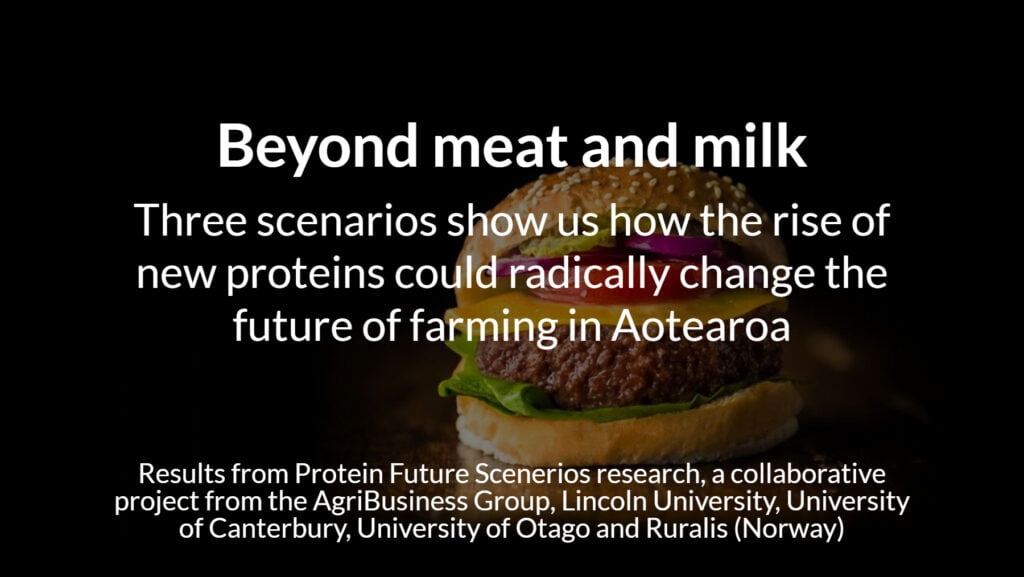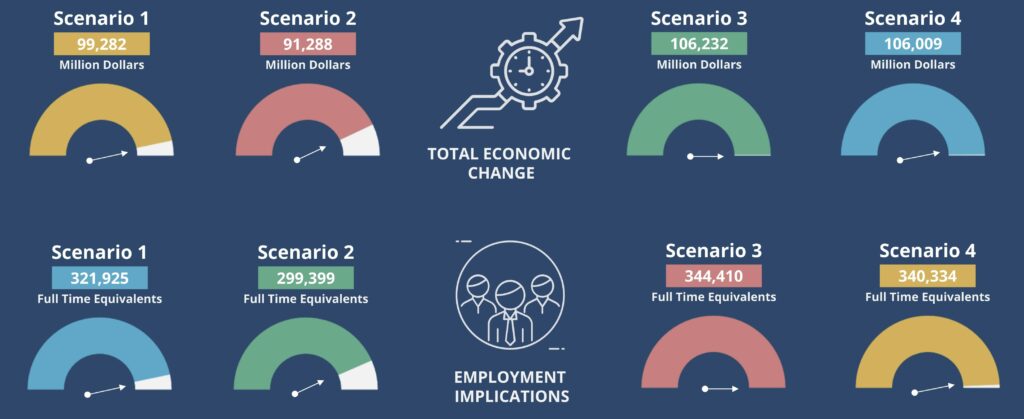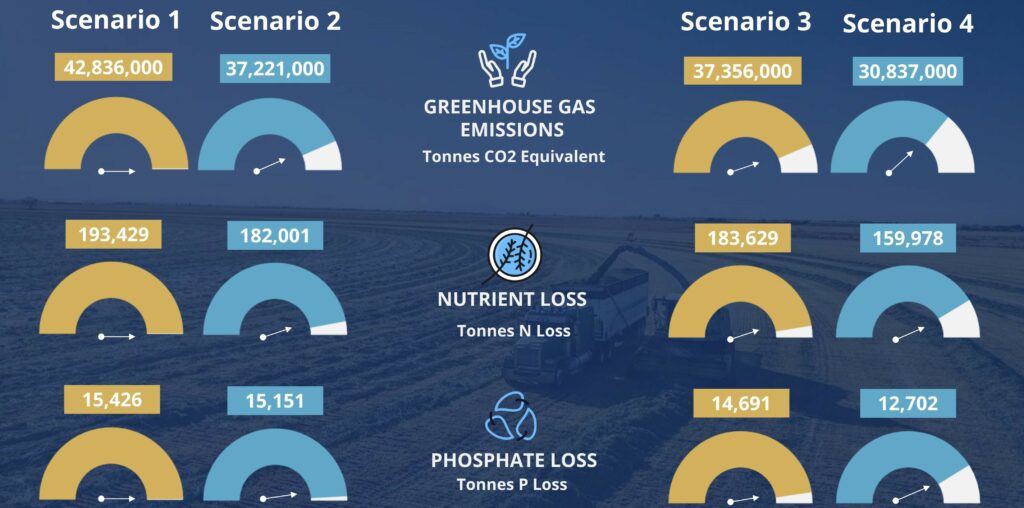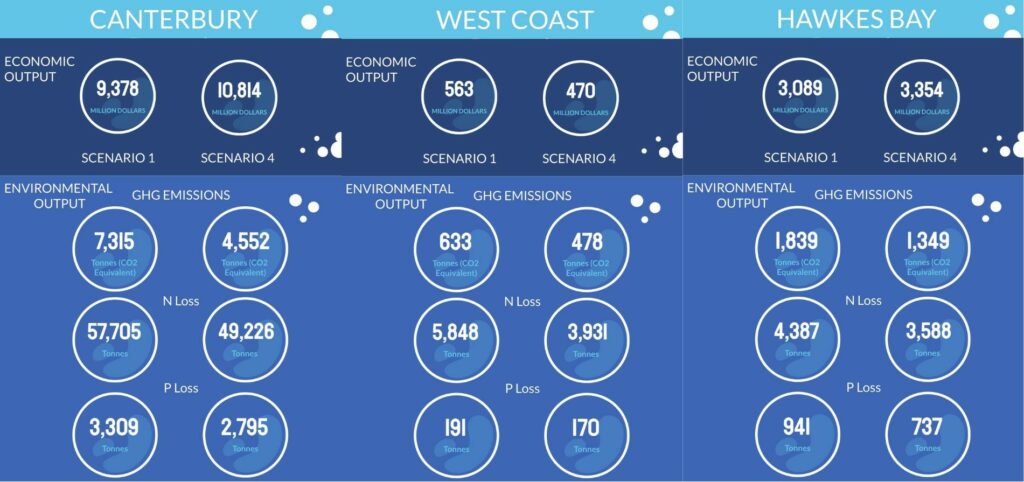Alternative Proteins Will Change Farming in New Zealand – New Research Forecasts How, Where and Why
New Zealand needs to prepare for significant changes to our key food export markets. New research looks at how the rise of alternatives to animal proteins could change the future of farming in Aotearoa.
New Zealand needs to prepare for significant changes to our key food export markets, finds a new report looking at how the rise of alternatives to animal proteins could change the future of farming in Aotearoa.
Alternative proteins are likely to significantly affect the global market for proteins, as food technology improves and diets change in response to concerns about climate change and animal welfare.
“Countries that are dependent on importing food from countries such as Aotearoa, like China and the UK, will increasingly be able to produce more of their own alternatives to animal protein as technology advances,” warns research lead Jon Manhire, director of The AgriBusiness Group.
The dairy sector in New Zealand is more threatened by the development of new proteins than our meat producers, found the research.
The Protein Future Scenarios research project, funded by the Our Land and Water National Science Challenge, investigated the potential impact on New Zealand of the global growth of new proteins that could compete with milk and meat products.
The research team modelled the economic and environmental implications of three plausible future scenarios against a baseline scenario. The three future scenarios were based on different rates of technological advancement for the main alternative protein technologies, with associated growth in consumer demand.
The worst economic scenario predicted by the research was associated with the potential growth of precision fermentation, which uses fermentation and yeasts to replicate dairy products. This could increase the global supply of dairy proteins and reduce prices for traditional New Zealand dairy products.
Technologies to reproduce dairy ingredients are more advanced than those for meat proteins. Whey derived from precision fermentation is already in commercial production, and casein and milk fats can also be produced.

Demand for proteins is expected to increase globally due to population growth and changing diets. However, this won’t automatically drive increased production from New Zealand’s animal protein sector, because the increased demand could be met by alternative proteins, suggests the research.
Greater global demand for plant protein will have economic and environmental benefits for New Zealand, but the economic benefits will be unevenly distributed, says Dr Christopher Rosin of Lincoln University, part of the research team.
“The modelling exercise indicates that precision fermentation has negative economic impacts, mostly for our dairy sector, but does have positive environmental impacts. Cell-cultured protein is principally likely to have negative impacts on the New Zealand meat sector,” says Dr Rosin.
“If widespread availability of cheap alternative proteins reduce profits for our beef, sheep and dairy farmers, we're likely to see land-use change into arable, horticulture and carbon farming. This will have positive economic benefits for those sectors, but would reduce the size of our pastoral sector.”


The research models showed that alternative proteins may have a relatively minimal impact on New Zealand agriculture when projected until the year 2035, but significantly greater impacts were identified when the modelling horizon was extended to 2050.
“Long-term modelling forecasts – like long-term weather forecasts – are less certain,” says Manhire, “but we’re confident the research shows the likely trend in direction.” Most experts interviewed as part of the research agreed the results reflected the impact they expect from increased production of alternative proteins.
Regional economic outlooks were developed for the scenarios. These include impacts over time on employment, land use, and environment, to inform long-term planning and regional development. For example in Canterbury, a scenario for 2050 in which all alternative proteins take off has the potential to decrease greenhouse gas emissions by over one-third, and decrease nitrogen loss by almost 15% while increasing economic output 15% with a shift of some intensive dairy to horticulture and arable land use.

Another key finding of the research was that the impact of increasing global demand for new proteins on New Zealand’s meat and milk industry will be higher if we don’t mitigate our agricultural greenhouse gas emissions and meet high standards for animal welfare and water quality.
This is because a desire to live more sustainability drives some people to want to eat alternative proteins, which can be marketed as having a lower greenhouse gas footprint.
The New Zealand pastoral sectors’ points of difference may increasingly be as an exporter of high-quality ` ‘natural’ meat and milk products, which will appeal to a different market than their highly processed alternatives.
New Zealand also has the opportunity to become a major producer of alternative proteins. This is because significant quantities of renewable energy are needed, and New Zealand’s supply of hydro and increasingly wind power put us in a good position to manufacture alternative proteins in the future.
Producing large quantities of protein through precision fermentation and cell-culture processes will require a massive supply of inputs such as serum and yeasts, and this emerging ‘feed industry’ could also provide opportunities for Aotearoa.
A national policy or strategy is needed to help New Zealand prepare for the risks and potential opportunities of new proteins, say experts in the New Zealand meat and dairy export industry who were involved in the research.
Our current scenario, where the pace of technological advancement is slow, is unlikely to continue, says Manhire.
“There is a high level of interest and investment in alternative proteins, and many recent technological advancements, especially in cell-cultured protein, which can replicate meat from any species in a laboratory. Although investment in novel protein companies slowed down significantly last year, our research suggests this was due to a settling of optimism and enthusiasm, into a more realistic view of the pace of development in technology and scale of production. It was also a reflection of general investment trends for 2023.”
A webinar to learn more about the research will be held on 16 April 2024 at 10am. Registrations are open to all.
More information:
- Read the report summary
- Read the full report: Protein Futures: Future Scenarios for Land-Use in Aotearoa New Zealand Synthesis Report
- Protein Future Scenarios project webpage
Author
One response to “Alternative Proteins Will Change Farming in New Zealand – New Research Forecasts How, Where and Why”
Greetings Mr Manhire and Mr Rosin ,
Where is this alternative to grass fed milk ,and meats coming from ?
The WHO…?this Organization is entirely against our farming methods .we are the best converters of grass into life sustainable Protein .Who is paying your career wages ?
Isn’t Lincoln/ Massey set up for OUR COUNTRIES protein Producing Farmers ..?Isn’t all this “Woke science ” ,along with Climate change,Carbon fraud ,ETS ,being peddled
By the UN ,WHO..to pull down our
Very Democratic roots ..our Sovereignty..?Can These lab made products possibly substitute OUR FARMERING YEARS OF EXPERTISE..
WHAT ARE THE SIDE EFFECTS OF
THESE INVENTED SOURCES OF SO CALLED PROTEIN ..?Sincerely Robert McLean Whangaehu, Porangahau HB Coast
 View Our Strategy Document 2019 – 2024
View Our Strategy Document 2019 – 2024




Leave a Reply